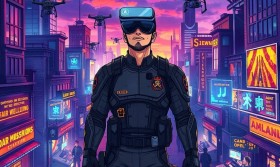Title: Beyond Reality: How the 'Direct Missions' DLC Transforms Film Simulator VR into the Ultimate Cinematic Playground
The virtual reality landscape is perpetually evolving, but few applications have captured the creative spirit of filmmakers and enthusiasts quite like Film Simulator VR. This innovative platform transformed users from passive viewers into active directors, offering a virtual sandbox with professional-grade cameras, lighting rigs, and sets to craft stunning cinematic pieces. Its core appeal was the limitless freedom to create. Now, with the release of its first major expansion, the 'Direct Missions' DLC, the experience undergoes a profound metamorphosis. It doesn’t just add content; it redefines the game’s purpose by introducing structure, challenge, and a thrilling new layer of narrative-driven gameplay that tests your directing chops under pressure.

For the uninitiated, Film Simulator VR is a director's dream simulator. Using motion controllers, players can physically manipulate cameras on dollies and cranes, adjust the intensity and color of virtual lights, position props, and direct AI actors to hit their marks and convey specific emotions. It was, and remains, an unparalleled tool for learning the principles of cinematography, blocking, and visual storytelling in a zero-cost, zero-risk environment. You could spend hours meticulously crafting a single, perfect shot. The 'Direct Missions' DLC respects this foundational freedom while answering a compelling question: What happens when directorial vision meets a ticking clock and a demanding client?
The DLC introduces a new menu option: the "Mission Board." This is your portal to a series of contracts from a diverse range of in-universe clients, from a gritty neo-noir detective agency to a high-gloss corporate advertising firm and a desperate, low-budget sci-fi producer. Each mission is a unique brief with a clear set of Objectives and strict Constraints. A mission might task you with filming a 30-second car commercial that "evokes a sense of freedom and luxury" using only three specific camera angles and a maximum of two lighting setups. Another might drop you into a chaotic cyberpunk alleyway and demand you capture a "tense exchange between two informants" where the dialogue must be clearly audible, forcing you to strategically place microphones amidst the ambient sound of rain and neon-hum.
This is where Film Simulator VR evolves from a serene creative suite into a pulsating puzzle game. The constraints are the heart of the challenge. You’re no longer just asking, "What looks good?" You’re solving a multi-layered problem: "How do I convey 'suspense' with a locked-off camera and no close-ups?" or "How do I make this product look appealing using only this single, harsh key light?" These limitations are genius—they mirror real-world filmmaking challenges where budget, time, and technical hurdles force directors to innovate. In VR, this translates to a deeply immersive and satisfying loop of planning, execution, and adaptation.
The pressure is amplified by the introduction of a live "Action!" phase. Once you’ve prepped your set, positioned your actors, and planned your shots, you hit the virtual clapperboard. The scene plays out in real-time, and you must execute your plan. A camera dolly you didn’t secure properly might wobble, an actor might miss a mark, or you might realize your chosen lens doesn’t frame the crucial action. There are no pauses or rewinds during a take. This injects an incredible amount of tension and excitement, mirroring the adrenaline rush of a live film set. Failure is a possibility, but it’s never frustrating—it’s a learning moment. You simply go back to the planning stage, adjust your strategy, and call "Action!" again.
Upon completing a take, the DLC’s robust Grading System kicks in. Your footage is automatically compiled and submitted to the client. You’re then graded on three key metrics: Technical Execution (were the shots in focus, was the audio clear?), Creative Vision (did the tone and composition match the brief?), and Efficiency (did you stay within the constraints?). Achieving a high score unlocks harder missions, new equipment—like specialized anamorphic lenses or vintage filters—and cosmetic items for your virtual director’s chair or office.
Beyond the gameplay mechanics, the 'Direct Missions' DLC is a masterclass in #VirtualCinematography and #VREducation. It stealthily teaches complex concepts. To solve a mission, you must intuitively understand the emotional impact of a low-angle shot versus a high-angle one, the mood set by warm versus cool lighting, and the narrative pace dictated by editing choices. It’s active learning disguised as exhilarating fun.
In conclusion, the 'Direct Missions' DLC is not a side feature; it is a essential expansion that completes the Film Simulator VR vision. It successfully marries the unbridled creativity of the base game with compelling, structured challenges that test every facet of a user's directorial instinct. It provides a tangible sense of progression and accomplishment that the sandbox mode, for all its beauty, lacked. By imposing constraints, it doesn’t stifle creativity—it fuels it. For aspiring filmmakers, it’s an invaluable training tool. For gamers, it’s a unique and refreshing puzzle-solving experience. This DLC solidifies Film Simulator VR's position not just as a remarkable simulator, but as a groundbreaking #VRGaming title that truly earns the label of #DirectorsCut. The mission is clear: your call time is now.


















